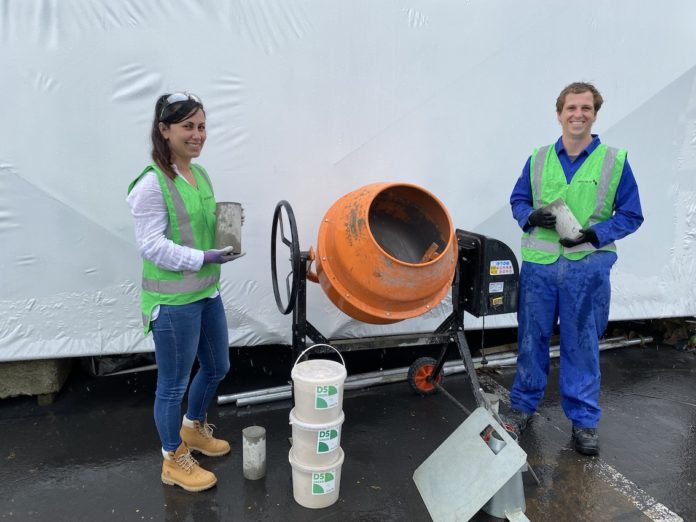Kiwi company Neocrete’s innovation is reducing carbon in concrete — including precast panels in Kainga Ora developments and the Auckland City Rail Link.
In November, world leaders met in Glasgow to discuss more ambitious goals to reduce greenhouse gas emissions. New Zealand pledged to half emissions by 2030.
One key part of this challenge is the manufacture of concrete, which accounts for 8% of man-made emissions.
Yet we are not about to stop using the most popular product on earth (after water). In fact, use of concrete will increase, according to the New Zealand Infrastructure Commission’s new Physical Resources Study, as we build the infrastructure we need to transition to a low-carbon economy.
This means that concrete must evolve into a much more sustainable material. The key, the Infrastructure Commission says, could be the ancient material called pozzolans.
Pozzolans: a forgotten treasure
A pozzolan is any silicate material that forms a cement when mixed with calcium-rich water.
“Before the invention of Portland cement, which contains both calcium and silica, pozzolan-based concrete dominated for two millennia,” according to Jackson MacFarlane, who recently returned to New Zealand after finishing his PhD on pozzolans at Stanford University.
“Romans made concrete by mixing lime and volcanic ash to form a mortar. Water hydrates the lime and reacts with the pozzolans in the ash to cement everything together,” MacFarlane says.
“The resulting material is strong and durable — as anyone who has visited Italy can tell you!”
While durable, the problem with pozzolans is they slow the setting time of concrete. This is why they have been largely replaced by the faster-setting Portland cement.
Today, the only pozzolans that are still used as partial cement substitutes are by-products of coal power plants and metal production — mostly fly ash and silica fume. Their supply is set to dimmish as we move to greener technologies.
But as we search for a greener way to make concrete, pozzolans are making a comeback, this time with new technology to overcome old problems.
Kiwi innovation solving a global challenge
It is this search which drew MacFarlane back to New Zealand to work with Kiwi company Neocrete, a global frontrunner in the race to make concrete sustainable.
“Neocrete’s pozzolan-based concrete admixture, D5 Green, actually accelerates concrete setting, without losing the durability that pozzolanic concrete is known for,” MacFarlane says.
“The great thing is that it does it with natural volcanic pozzolans, abundant here in New Zealand.”
On any day during the latest lockdown, instead of being cooped up in a Stanford University office, you will find MacFarlane in gumboots, testing trial batches of concrete at Neocrete’s lab in Auckland.
“We believe pozzolans are the answer to concrete’s sustainability challenge,” Neocrete co-founder Zarina Bazoeva says.
Bazoeva’s family has been working with natural pozzolans for the past 30 years, adapting them to improve the strength, water-resistance, durability and setting time of concrete.
The strength that D5 Green adds to concrete allows a reduction in cement — and, thereby, carbon. This is what Neocrete research and development has focused on since 2018, with help from Jackson and the concrete industry.
“Our latest trials demonstrate 25% cement reduction. With industrial pozzolans added, we reduce overall embodied carbon by 40%, with no loss in strength, including early strength,” Bazoeva says.
Coming in dry powder form, D5 Green can be added at concrete or cement production stage, which means both cement and concrete manufacturers can benefit from it.
The product has BRANZ accreditation and a full range of trial data on its web site.
Low-carbon Neocrete D5 Green — pouring in your neighbourhood
Neocrete’s flagship product D5 Green is already being used around New Zealand.
Early adopters such as Concretec and Stevenson Concrete are using Neocrete D5 Green to reduce the embodied carbon and accelerate curing time in concrete panels for the Auckland City Rail Link and for Kainga Ora. LT McGuinness has used D5 Green in new buildings at Scots College, Wellington.
“We now have the ability to reduce carbon emissions from concrete. The challenge is the lack of incentives for industry to use it,” Bazoeva says.
“The early adopters alone won’t get us to 50% reduction in emissions by 2030. We need government to step up with better incentives for businesses to adopt green technology. We also need more agencies to take a leadership role, like Kainga Ora.”
For MacFarlane, using the power of pozzolans is a no-brainer. “This is an opportunity for New Zealand to lead the world building a sustainable future — we just have to grab it.”




